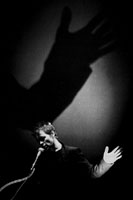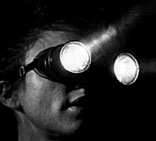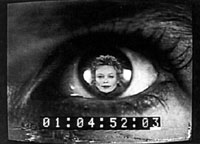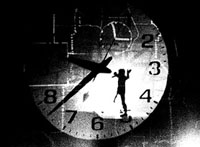PERFORMANCE PLUS: NOTES ON LAURIE ANDERSON
by Edward Cella
Poised Chaplinesque before an enormous film projection, Anderson gingerly waves her violin bow, as if to tempt the spectator's imagination; for a moment her magic wand appears to summon the illusion. The rhetoric of such sorcery, however, is blasted as the viewer realizes that he is witnessing the action of technology and not the magical power of the artist.1Long before the current fashion for technology was reflected in the many popular magazines suffering from what might be best called technoenvy, Laurie Anderson began visualizing the intersection of image, sound and word electronically in her multimedia presentations. Her first major multimedia performance tour in five years, the Nerve Bible, nevertheless seems less a triumphant celebration of having arrived at this new multimedia age than a personal, often autobiographical, campfire tale--electronic, of course--that is at once compelling and eerie.
 For those who thought that Anderson's best work was behind her, the recent release of a variety of new materials should be cause for re-examination. Anderson released Stories from the Nerve Bible in 1993. This self-compiled anthology is, in her words, "not autobiography... [but] an account of the many performances and projects I've done in the last twenty years, roughly chronological, although it keeps jumping back and then forward in time."2 Arranged by project title and recurrent themes, the book contains photographs, drawings, script fragments, and many of Anderson's often absurdist observations. Stories was followed in 1994 by her sixth album for Warner Brothers, Bright Red, the first since 1989. Produced by Brian Eno, who lends lean keyboard and percussion dominated arrangements, the album features the chant-like track "In Our Sleep," the result of a collaboration between Anderson and Lou Reed.
For those who thought that Anderson's best work was behind her, the recent release of a variety of new materials should be cause for re-examination. Anderson released Stories from the Nerve Bible in 1993. This self-compiled anthology is, in her words, "not autobiography... [but] an account of the many performances and projects I've done in the last twenty years, roughly chronological, although it keeps jumping back and then forward in time."2 Arranged by project title and recurrent themes, the book contains photographs, drawings, script fragments, and many of Anderson's often absurdist observations. Stories was followed in 1994 by her sixth album for Warner Brothers, Bright Red, the first since 1989. Produced by Brian Eno, who lends lean keyboard and percussion dominated arrangements, the album features the chant-like track "In Our Sleep," the result of a collaboration between Anderson and Lou Reed.
In 1995, in addition to the Nerve Bible tour, she released The Ugly One with the Jewels, a live recording of a 1994 performance of readings, and, for the first time, a CD-ROM. Puppet Motel is issued by Voyager, an interactive media publisher, and the sponsor of Anderson's tour. Advertised as "offering ways to join, alter, and record the Anderson experience," the CD-ROM provides six hours of talk, images, and music that includes the premiere of the song "Down in Soho." If that wasn't enough, Internet users with access to the World Wide Web will also be able to visit the "Green Room," which features video clips, audio clips, and text documenting the Nerve Bible tour, and conversations between Laurie Anderson and special visitors to her actual Green Room. The home page is located at http://www.voyagerco.com.
This renaissance of activity is in part due to Anderson's self-admitted workaholic tendencies, rekindled after the resoundingly negative reviews she received for her last album, Strange Angels; this recent flurry also represents a coming of age for her. More precisely, the new work represents the confluence of many of the ideas she has been working on throughout her twenty-five-odd-year career and a broader, more widely felt Gestalt. The phrase "multimedia performance artist" was coined to describe Anderson's work of the late 1970s and early 1980s. Now, of course, many of our homes have multimedia entertainment centers and multimedia computers. Despite the fact that little of what is received on them resembles art in any way, they nonetheless represent an amplification and proliferation of the media's access to our daily lives--a theme that is central to Anderson's oeuvre.
In a world in which technology has made it possible to connect previously different devices, the mass media have capitalized on the opportunity to reproduce and distribute their commodities through the variety of newly combined mediums. Anderson, never reliant on any single medium, simultaneously produces works in a ever larger and more divergent array of mediums. As Maurice Berger notes, "In the context of a single work, Anderson may serve as writer, composer, inventor, photographer, filmmaker, musician, and actor. Eschewing the traditional media of Modernist art--painting and sculpture--Anderson opts instead for technology: slide projections, synthesized sound, and film enter the discourse of her performance."3
 Anderson's impetus to explore is partly enabled by her conscious self-labeling as a performance artist. Performance art, at least as it developed in the mid 1970s in New York City, maintained the audience/performer mode of theater while dispensing with traditional plot and characterization, as many artists presented themselves as the actors/writers/impresarios of their own events. Often performed in galleries, museums, and alternative spaces, performance art relaxed the integrity of the traditional genres usually exhibited in such contexts by drawing from film, music, and dance as well as theater. By the mid 1980s, Anderson's reputation as one of the most respected and successful performance artists brought multi-album contracts, commissions, and the fame usually associated only with pop stars.
Anderson's impetus to explore is partly enabled by her conscious self-labeling as a performance artist. Performance art, at least as it developed in the mid 1970s in New York City, maintained the audience/performer mode of theater while dispensing with traditional plot and characterization, as many artists presented themselves as the actors/writers/impresarios of their own events. Often performed in galleries, museums, and alternative spaces, performance art relaxed the integrity of the traditional genres usually exhibited in such contexts by drawing from film, music, and dance as well as theater. By the mid 1980s, Anderson's reputation as one of the most respected and successful performance artists brought multi-album contracts, commissions, and the fame usually associated only with pop stars.
Anderson's current representation in and access to television, radio, print, or interactive media, as with Puppet Motel, is almost unique. Critics in the art community have often labeled her a sell-out, as they did when they panned her 1989 album, Strange Angels; however, her acceptance by popular culture has been just as tenuous. Betwixt and between, Anderson seems content to colonize mediums yet farther afield and, in the process, becomes both a performer and a performing artist. As in the proliferation of overlapping mediums in the mass media, Anderson constructs redundant message systems that circulate her own signs. Denying the primacy of any of the formats she works in, every element in her cosmos of signs and stories becomes fodder for some new project, in some other format. Even though they are interrelated, "determining which of Anderson's mass media are based on exactly which would require the chart-making skills of a professional chicken/egg theorist."4
 Technology is a touchstone in Anderson's recent work. Twenty years ago, personal computers were little more than souped-up calculators and typewriters; today, they are not only omnipresent but also represent an advance in technology no less great than the jump from stone to iron. When the history of this advancement is written, it will be filled almost exclusively with white, hetero male inventors like Bill Gates and Steven Jobs. Although Anderson must be seen as a bete noir product of the same age. She shares the motivations of the many modern-day Edisons who seem to be able to construct ever-faster microprocessors and the computer programs which run on them, she notes, "A lot of my work comes from just playing around with equipment, seeing what it will do... Fortunately for me, I live on Canal Street, the Used Electronics Junk Capital of the World, and I've learned about material by buying cheap junk and taking it apart and then trying to put it back together so that it will do something it didn't do before."6 In twenty years of collaboration with Bob Bielecki, an electronics designer, Anderson has created chopped electric violins (the Tape Bow Violin or the Viophonograph, to name two), voice activated synthesizers (the Vocorder), the percussion-suit and, most notably, increasingly elaborate computer-run multimedia tours.
Technology is a touchstone in Anderson's recent work. Twenty years ago, personal computers were little more than souped-up calculators and typewriters; today, they are not only omnipresent but also represent an advance in technology no less great than the jump from stone to iron. When the history of this advancement is written, it will be filled almost exclusively with white, hetero male inventors like Bill Gates and Steven Jobs. Although Anderson must be seen as a bete noir product of the same age. She shares the motivations of the many modern-day Edisons who seem to be able to construct ever-faster microprocessors and the computer programs which run on them, she notes, "A lot of my work comes from just playing around with equipment, seeing what it will do... Fortunately for me, I live on Canal Street, the Used Electronics Junk Capital of the World, and I've learned about material by buying cheap junk and taking it apart and then trying to put it back together so that it will do something it didn't do before."6 In twenty years of collaboration with Bob Bielecki, an electronics designer, Anderson has created chopped electric violins (the Tape Bow Violin or the Viophonograph, to name two), voice activated synthesizers (the Vocorder), the percussion-suit and, most notably, increasingly elaborate computer-run multimedia tours.
 But Anderson never remains for long on the level of technology per se. Rather, she cannibalizes technology in order to expose its replacement of meaningful communication with the circulation of messages. Moreover, as John Howell has noted, "[Anderson] has distinguished herself from the throng of artists who work with complicated technology by using it in a context of empathetic performance."7 Anderson writes, "For me, electronics have always been connected to storytelling. Maybe because storytelling began when people used to sit around fires and because fire is magic, compelling and dangerous. We are transfixed by its light and by its destructive power. Electronics are modern fires."8
But Anderson never remains for long on the level of technology per se. Rather, she cannibalizes technology in order to expose its replacement of meaningful communication with the circulation of messages. Moreover, as John Howell has noted, "[Anderson] has distinguished herself from the throng of artists who work with complicated technology by using it in a context of empathetic performance."7 Anderson writes, "For me, electronics have always been connected to storytelling. Maybe because storytelling began when people used to sit around fires and because fire is magic, compelling and dangerous. We are transfixed by its light and by its destructive power. Electronics are modern fires."8
In Anderson's most recent projects, the focus has shifted. Anderson's work of the late 1980s explored the multitude of replacements, repetitions, and (mis) representations that technology has afforded. This was exemplified best by the processed video clone of herself that Anderson created to co-host the 1987 PBS series, Alive from Off Center. In one of the episodes, Anderson explained to "talk show host" Spalding Gray that her fame now kept her so busy that she had no time to do her actual work. As a result, she thought, "You wished there was another you."9 The three-foot-high chain-smoking clone, an off color parody of the cool Anderson, amusingly advertised the crisis in authenticity--a perfect simulacrum with no original.
Since then, it has become possible for an ever-increasing segment of the industrialized world's population to "plug in" and live a fictive reality, on-line. Anderson's observations on this resonate in her most recent works. For instance, the lyrics of Puppet Motel, Anderson's metaphor for the Internet's bulletin boards, read:
Now about the residents/ Of the Puppet Motel They're more than a little spooky/ And most of them are mean. They're runnin' the numbers/ They're playing cops and robbers Down in the dungeons/ Inside their machines... They're runnin' around in a frenzy/ In search for the Holy Grail. They're havin' virtual sex./ They're eatin' virtual food. No wonder these puppets/ Are always in a lousy mood.
The lyrics fit within Anderson's larger study of the United States which, as Anderson notes, "[forms the] background for everything my work is about: memory, language, technology, politics, utopia, power, men and women."10 The lyrics also underscore the much slower evolution of human nature that has accompanied the ten-fold increase in technology's sophistication.
In the second half of the Nerve Bible, Anderson further maps technology's impact on human culture. She suggests the outcome of our ever-deeper looking into outer space, now clearer than ever before thanks to a multi-billion dollar orbiting observatory. With the help of a distorting camera on the end of a microphone, Anderson's projects her face onto a giant suspended red disk, where she becomes a cosmic red dwarf. The way in which Anderson's responds "You rang?," as Chris Willman noted, "[is] sort of like the God of the book of Job, but afflicted with cosmic PMS as much as divine peevishness." By superimposing on a projected film clip of male, 1950s vintage, Hawaiian hula dancers the words "One World One Operating System," Anderson elegantly problematizes cyberspace's technological colonization of the world.
Although, in her previous work, Anderson presides as a kind of high priestess of multimedia technologies, in her newest work she rekindles a more central theme. Despite (or, rather, as a result of) the integrations discussed above, Anderson ventures past casual observation via her metaphor for the body, The Nerve Bible, and addresses these changes in terms of herself. That is to say, she redirects her attention to the central human themes of memory, life, and death through vignettes of autobiography and story set to light, sound, and gesture. These explorations are not new to Anderson's repertoire, but they have been thinly scattered among her primarily language- and media-focused works of the last ten years.
One of the conclusions Anderson draws in the Nerve Bible is that the body is not quite the ultimate multimedia machine. In her live performances, Anderson likens the eyes to primitive cameras: "The pans are a mess, and the dolly shots are awful.... If you saw the dailies, you'd fire the cameraman." Luckily, "Your mind has fixed it all up for you." Periodically, throughout the performance, the phrase "Save now... Out of memory" drones, reminding us that, like machines, our memory is one of our most fragile commodities.
Anderson's characteristic hypnotic presence--or non-presence--remains at the center and rises to a climax with her scripted digressions. Stripped of multisensory frou-frou, Anderson uses these moments to recount personal tales with the intimacy of diary entries.  In one, she humorously speaks of her grandmother, a Holy Roller missionary, who goes to Japan to convert Buddhists using only hand gestures, sign language, and hymns sung in English, with the result being that the prospective converts had "absolutely no idea what she was taking about." Later, Anderson recounts her frightening trip to a Tibetan mountainside, where she came close to death due to altitude sickness and had to be carried down the mountain on the back of a donkey, unable to hear anything except ringing and see anything except pulsating lights. These stories, all autobiographical, appear and reappear throughout the performance and add up to a highly stylized and completely un-naturalistic self-portrait. They also comprise the Bible referred to in the work's title by resembling in a fantastic way the actual Bible, the first book Anderson remembers being introduced to, containing strange stories that adults taken as truth. Like the Bible, Anderson's work is filled with references to blood, war, and death, and it is brought to conclusion by an apocalypse, of sorts: a laser light tornado engulfing Anderson as she performs a violin solo. As an electronic campfire tale, Nerve Bible proves to be a striking mix of the personal and technological; nonetheless, it is Anderson's most autobiographical and intimate work since the late 1970s. At times critical, poignant, and humorous, Laurie Anderson's new works are her most successful yet.
In one, she humorously speaks of her grandmother, a Holy Roller missionary, who goes to Japan to convert Buddhists using only hand gestures, sign language, and hymns sung in English, with the result being that the prospective converts had "absolutely no idea what she was taking about." Later, Anderson recounts her frightening trip to a Tibetan mountainside, where she came close to death due to altitude sickness and had to be carried down the mountain on the back of a donkey, unable to hear anything except ringing and see anything except pulsating lights. These stories, all autobiographical, appear and reappear throughout the performance and add up to a highly stylized and completely un-naturalistic self-portrait. They also comprise the Bible referred to in the work's title by resembling in a fantastic way the actual Bible, the first book Anderson remembers being introduced to, containing strange stories that adults taken as truth. Like the Bible, Anderson's work is filled with references to blood, war, and death, and it is brought to conclusion by an apocalypse, of sorts: a laser light tornado engulfing Anderson as she performs a violin solo. As an electronic campfire tale, Nerve Bible proves to be a striking mix of the personal and technological; nonetheless, it is Anderson's most autobiographical and intimate work since the late 1970s. At times critical, poignant, and humorous, Laurie Anderson's new works are her most successful yet.
Notes
1. Beger, Maurice. Endgame: Strategies of Postmodern Performance.. New York: Hunter College Art Gallery, 1984, 5.
2. Anderson, Laurie. Stories from the Nerve Bible: A Retrospective 1972-1992. New York: Harper Perennial, 1994, 6.
3. Beger, Maurice. Endgame: Strategies of Postmodern Performance, 5.
4. All providing a monetary success which freed her from many of the funding questions many of her art world colleagues struggle with.
5. Willman, Chris. "Anderson Invites One and All to Her Electronic Campfire," LA Times, February 23, 1995, F9.
6. Anderson, Laurie. Stories from the Nerve Bible: A Retrospective 1972-1992, 81.
7. Howell, John. Laurie Anderson. New York: Thunder's Mouth Press, 1992, 19.
8. Anderson, Laurie. Stories from the Nerve Bible: A Retrospective 1972-1992, 175.
9. Ibid., 7.
10. Willman, Chris. "Anderson Invites One and All to Her Electronic Campfire," LA Times, February 23, 1995, F9.

